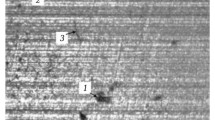On the basis of systematization of the results of investigation of the process of diamond grinding of Al2O3, TiC, Si3N4 –TiC, Y–TZP, and SiSiC ceramic specimens, we managed to identify some general and specific features in the structures of their surface layers. These features are used to make an adequate choice of the basic elements of microstructural model and to make some assumptions. The developed model presented in the form of a structure takes into account the real structure of the surface layer and the conditions of contact with elastic body.


Similar content being viewed by others
References
T. M. A. Maksoud, A. A. Mokbel, J. E. Morgan, et al., “Evaluation of surface and subsurface cracks of ground ceramic,” J. Mater. Process. Technol., 88(1 – 3), 222 – 243 (1999).
J. Chen, Q. Fang, P. Li, et al, “Effect of grinding wheel spindle vibration on surface roughness and subsurface damage in brittle material grinding,” Int. J. Mach. Tools Manufact., 91, 12 – 23 (2015).
Z.-H. Xie, R. J. Moon, M. Hoffman, et al, “Role of microstructure in the grinding and polishing of a-sialon ceramics,” J. Europ. Ceram. Soc., 23(13), 2351 – 2360 (2003).
G. K. R. Pereira, T. Silvestri, R. Camargo, et al, “Mechanical behavior of a Y–TZP ceramic for monolithic restorations: effect of grinding and low-temperature aging,” Mater. Sci. Eng., C, 631, 70 – 77 (2016).
O. Gavalda Diaz, D. A. Axinte, P. Butler-Smith, et al, “On understanding the microstructure of SiC/SiC ceramic matrix composites (CMCs) after a material removal process,” Mater. Sci. Eng. A, 743, 1 – 11 (2019).
V. Kuzin, “A model of forming the surface layer of ceramic parts based on silicon nitride in the grinding process,” Key Eng. Mater. Precis. Machin., 496, 127 – 131 (2012).
S. Arai, S. A. Wilson, J. Corbett, et al., “Ultra-precision grinding of PZT ceramics—surface integrity control and tooling design,” Int. J. Mach. Tools Manufact., 49(12/13), 998 – 1007 (2009).
V. Kuzin, S. Grigoriev, S. Fedorov, et al., “Surface defects formation in grinding of silicon nitride ceramics,” Appl. Mech. Mater., 752/753, 402 – 406 (2015).
Zh. Li, F. Zhang, X. Luo, et al., “Subsurface damages beneath fracture pits of reaction-bonded silicon carbide after ultraprecision grinding,” Appl. Surf. Sci., 448, 341 – 350 (2018).
J. Gao, J. Chen, G. Liu, et al., “Role of microstructure on surface and subsurface damage of sintered silicon carbide during grinding and polishing,” Wear, 270(1), 88 – 94 (2010).
V. V. Kuzin, S. Yu. Fedorov, and A. E. Seleznev, “Effect of the conditions of diamond grinding on tribological behavior of alumina-based ceramics,” J. Frict. Wear, 37(4), 371 – 376 (2016).
A. Juy and M. Anglada, “Strength and grinding residual stresses of Y–TZP with duplex microstructures,” Eng. Failure Anal., 16(8), 2586 – 2597 (2009).
L. Li, Y. Fang, Zh. Cai, et al., “Computer simulation of surface cracks behavior in anhydrous chemical conversion coatings on magnesium alloy,” Rare Metal Mater, Eng., 47(2), 431 – 435 (2018).
Y.-R. Liu, J.-J. Liu, B.-L. Zhu, et al., “The computer simulation of the temperature distribution on the surface of ceramic cutting tools,” Wear, 210(1/2), 39 – 44 (1997).
V. V. Kuzin and S. Yu. Fedorov, “Roughness of high hardness ceramic correlation of diamond grinding regimes with Al2O3-ceramic surface condition,” Refract. Ind. Ceram., 57(4), 388 – 393 (2016).
V. V. Kuzin and S. Yu. Fedorov, “Correlation of diamond grinding regimes with Al2O3–TiC-ceramic surface condition,” Refract. Ind. Ceram., 57(5), 520 – 525 (2017).
V. V. Kuzin, S. Yu. Fedorov, and S. N. Grigor’ev, “Features of Al2O3–TiC-ceramic specimen edge morphology formation during diamond grinding,” Refract. Ind. Ceram., 58(3), 319 – 323 (2017).
V. V. Kuzin, S. Yu. Fedorov, and S. N. Grigor’ev, “Correlation of diamond grinding regimes with Si3N4-ceramic surface quality,” Refract. Ind. Ceram., 58(1), 78 – 81 (2017).
V. V. Kuzin, S. Yu. Fedorov, and S. N. Grigor’ev, “Production process planning for preparing Si3N4-ceramic objects taking account of edge defectiveness,” Refract. Ind. Ceram., 58(5), 562 – 565 (2018).
V. V. Kuzin, S. Yu. Fedorov, and S. N. Grigor’ev, “Correlation of diamond grinding regime with surface condition of ceramic based on zirconium dioxide,” Refract. Ind. Ceram., 57(6), 625 – 630 (2017).
V. V. Kuzin, S. Yu. Fedorov, and S. N. Grigor’ev, “Level of Y–TZP-ceramic specimen edge defects after diamond machining,” Refract. Ind. Ceram., 58(4), 415 – 417 (2017).
V. V. Kuzin, S. Yu. Fedorov, and S. N. Grigor’ev, “Correlation of diamond grinding regimes with SiSiC-ceramic surface condition,” Refract. Ind. Ceram., 58(2), 214 – 219 (2017).
V. V. Kuzin, S. Yu. Fedorov, and S. N. Grigor’ev, “Technological provision of the quality of ring edges of silicon-carbide friction couples for the end seals of the pumps,” Refract. Ind. Ceram., 58(6), 647 – 651 (2018).
V. V. Kuzin, “Microstructural model of ceramic cutting plate,” Russian Eng. Res., 31(5), 479 – 483 (2011).
The present work was financially supported within the framework of the State Task of the Ministry of Science and Higher Education of Russian Federation, Project No. 0707-2020-0025.
Author information
Authors and Affiliations
Corresponding author
Additional information
Translated from Novye Ogneupory, No. 5, pp. 59 – 64, May, 2020.
Rights and permissions
About this article
Cite this article
Kuzin, V.V., Grigor’ev, S.N. & Volosova, M.A. Microstructural Model of the Surface Layer of Ceramics After Diamond Grinding Taking into Account Its Real Structure and the Conditions of Contact Interaction with Elastic Body. Refract Ind Ceram 61, 303–308 (2020). https://doi.org/10.1007/s11148-020-00477-1
Received:
Published:
Issue Date:
DOI: https://doi.org/10.1007/s11148-020-00477-1




